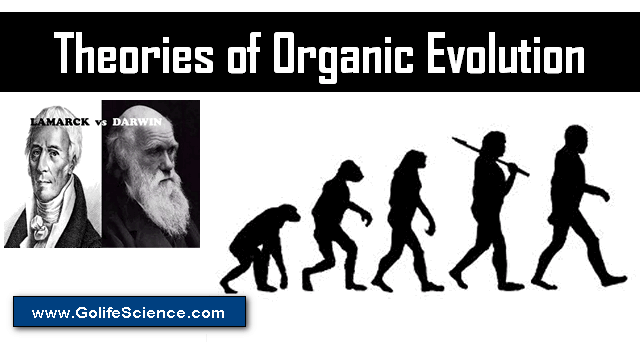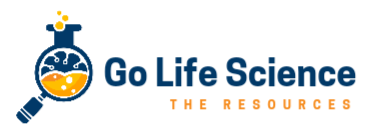
The Theories of Organic Evolution explain the convincing origin of life. It also explains how the wide variety of plants and animals came into existence in the world. According to this theory, the world has evolved and not been created.

Life originated spontaneously in the remote past from non-living inorganic substances. These substances reacted to organic compounds. The organic compounds developed into colloidal systems capable of stepwise improvements in order to give rise to a simple life.
Table of Contents
Basic Theories of Organic Evolution
In organic evolution, there are different theories of evolution. But five theories are accepted universally. They are
- Theory of inheritance of acquired characters (Lamarckism)
- Theory of natural selection (Darwinism)
- Modern synthetic theory of evolution,
- Weismanner’s germ plasma theory,
- Hugo DeVries “mutation theory”
1. Theory of Inheritance of acquired characters (Lamarckism)
Lamarckism is the first theory of organic evolution, proposed by “Jean-Baptiste de Lamarck”(1744-1829), a French biologist. This is one of the theories of organic evolution Lamarckism.
Lamarck scientist’s famous book is “Philosophie zoologique” (1809).
He announced a theory of organic evolution in 1801. It has been known as the “Theory of Inheritance of Acquired Characters.”.
His evolutionary ideas are:
- Internal forces of life increase the size of the organism because of an “inner want.” New structures appear.
- The direct environmental effect over living organisms
- Use of disuse
- Inheritance of acquired characters
Example:
- Giraffe due to the lack of surface vegetation gradually.
- Aquatic birds—they had to go to water due to lack of food. Structures like ‘web’ between the toes developed. Their wings gradually reduced for flight.
- Flatfishes (deep-sea fishes)
- Whales lost their hind limbs
- The Wanding birds (eg: -jacana) developed their long legs over generations. They stretched their legs to keep their body above the water level.
Neo-LaMar kists:
The evolutionists who support the Lamarckian theory of inheritance of acquired characters come under the heading “neo-Lamarckian” they are:
- Cope (1840-1897)
- Giared (1846-1908)
- Packard, Spencer & McBride
2. The theory of natural selection (Darwinism) (in 1859)
Charles Darwin explain natural selection in his book “the origin of species” (full title: “On the origin of species by means of Natural Selection” (or) “The preservation of favored races in the struggle for life”)
It includes the following elements:
- The universal occurrence of variation
- Overproduction (rapid multiplication) ):
- Every species, in the absence of environmental checks, tends to increase in a geometrical manner.
- A salmon produces 28,000 eggs in a season.
- A female rabbit gives birth to six young ones in one litter. It produces 4 litters in a year. A rabbit that is 6 months old is capable of reproduction. due to environmental checks, it will be control
- Elephants, in the absence of any checks, have 21 million descendants of the end of 800 years
- The struggle for existence:
- The intraspecific struggle between same species
- The interspecific struggle between different species
- Environmental struggles due to earthquakes, tidal waves, and the bursting of volcanoes are all causes for killing large populations.
- In the battle for survival, the majority of individuals perish. This happens because only a few survivors have necessary beneficial variations. This idea of the survival of the fittest is the core theory of natural selection.
- inheritance of useful variations: After organisms adjust to the surroundings, they transmit their useful variations to the next generation. Non-useful variations are eliminated.
- Neo-Darwinism: Neo-Darwinism’s a modified form of Darwinism.
- Neo-Darwinist is:
- H. Huxley,
- S.A. Geray,
- Herbert Spencer,
- Haeckel & D.S.Jordan,
- Weismann (Germplasm theory)
3. Modern synthetic theory of Evolution
This theory is the result of the work of a number of scientists, namely T.Dobzhansky, R.A.Fisher, J.B.S.Haldan, Small Wright, Ernst Mayr & G.L.Stebbins. ‘Stebbins’ in his book “Process of organic evolution” discussed the synthetic theory. This is one of the proven theories of organic evolution.
It includes the following factors:
- Mutation,
- variation (or) Recombination,
- Heredity,
- Natural selection,
- Isolation
(a). Mutation:
- Due to gene mutation (or) point mutation, the chemistry of gene (DNA) alter & able to change its phenotypic effect.
- Most of the mutant genes are recessive to the normal gene. These genes can express phenotypically only in homozygous condition. Thus, gene mutation tends to produce variations in the offspring.
- Mutations: What are Mutations and their types
(b). Variation (or) Recombination:
- The production of gene combination containing the same individual produces heterozygous individuals (meiosis)
- Random mixing of chromosomes from two parents during sexual reproduction to produce a new individual.
- The exchange between chromosomal pairs of particular alleles during meiosis, called “crossing over,” produces new gene combinations.
- Chromosomal mutations such as deletion, duplication, inversion, translocation, and polyploidy also result in variation.
(C). Heredity:
- The transmission of variation from parent to offspring is an important mechanism of evolution. It is favored in the struggle for existence. Offspring benefit from the advantageous characteristics of their parents.
(D). Natural Selection:
- Natural selection does not produce genetic change, but once it has occurred, it acts to encourage some genes over others. Further natural selection creates new adaptive relations between population and environment. It does this by favoring some gene combinations, rejecting others, and constantly modifying and molding the pool.
(E). Isolation:
- Isolation of organisms of a species into several populations or groups occurs under psychic, physiological, or geographical factors. These are thought to be among the most significant factors responsible for evolution.
4. Weismann’s Germ-plasm theory
“August Weisman” (1834-1914) was a neo-Darwinian biologist. He proposed the germplasm theory in his book “Das Keimplasma”. The term Keimplasma means germplasm.
- Theory is based on two kinds of living bodies. They are “Germplasm” (protoplasm of germ cells such as sperm and ova) and “somatoplasm” (protoplasm of somatic (or body cells). The Germplasm is responsible for the development of reproductive parts and remains in the organism. It is sealed and secluded from the somatoplasm. The somatoplasm develops out of the Germplasm.
- Somatoplasm is a discontinuous entity, and so any variation in it can’t be inherited. The somatoplasm doesn’t influence the Germplasm. So, Germplasm is immortal. It is perpetuated from generation to generation through meiosis. Somatoplasm is mortal. It perishes with the death of an organism.
- In 1904, Weizmann proposed a special particle. He called it the “idioplasm” (or “determinant).” This is a distinct part of an organism represented in the sex cells. Each determinant to be made up of still smaller units called “biophores”. These determinants are localized in the chromosomes of the nucleus.
- In opposition to Lamarck’s inheritance of acquired characters, Weismann introduced the idea of “parallel induction.” According to this concept, the stimulus affects the germ and somatoplasm at the same time.
- Polymorphism, Weismann developed the “hypothesis of germinal selection.”. He said that. There are many no. of determiners struggling for expression within the Germplasm and finally, one set is selected out by the environment.
- This is one of the Theories of Organic Evolution
Objections:
- Lacks any experimental support,
- It’s a failure for explaining the causes of asexual reproduction and regeneration.
Significance:
- The idea of continuity and immortality of Germplasm
- Understanding of the concept of particulate inheritance of Mendel.
- It provides some clue about genes (determinants )
- Proposes the division of Germplasm & Somatoplasm during cleavage of the zygote
5. Hugo de Vries – Mutation theory
- Hugo de Vries in his book “Die Mutation, the movie” (1901), proposed the mutation theory-
- He observed “Evening primrose,” “Oenothera Lamar Kiana.”. He studied this plant in wild forms for many years. He continuously observed certain spontaneous changes in some of these wild plants.
Mutation Theory:
Devries (1901), his theory states that evolution is a jerky process. New varieties and species are formed by a mutation. This mutation functions as a raw material of evolution.
Salient features are:
- Mutation, sports (discontinuous variations) are the raw material of evolution.
- The mutation suddenly manifests.
- Mutations do not revolve around the mean or normal character of these species.
- The mutation can appear in no. of individuals of a species.
- All mutations are inheritable.
- Mutations in all conceivable directions.
- Useful mutations are selected by nature, a lethal mutation from a single mutation.
- Evolution is a jerky and discontinuous process.
The importance of mutations in evolution:
- De-Vries stressed the randomness of variation, whereas Darwin considered the adaptiveness of the variation in evolution.
- De Vries stated that new species arise by a sudden jump, called mutation. Darwin considered that new species arise by the cumulation of gradual fluctuating variations in a series of generations. •
- H. Morgan observed mutations in Drosophila melanogaster and confirmed the mutation theory.
Objections:
- It couldn’t explain the existence of a discontinuity
- The device described certain numerical & structural changes in the chromosomes, but in “O.Gigas,” the mutant was found later to be due to polyploidy.
- Provide raw material for other forces to act upon it.
- It was not a satisfying explanation of the development of mimicry, the mutual dependence of flowers and pollinating insects.
